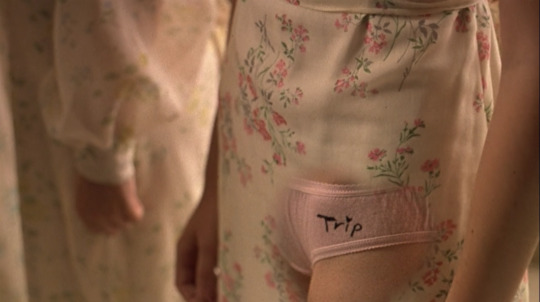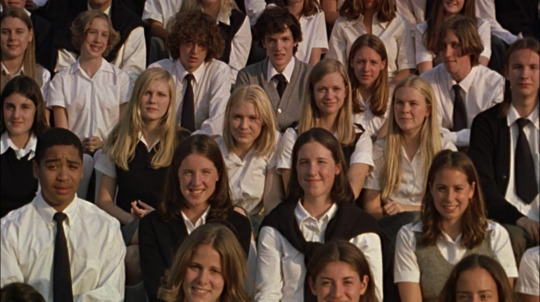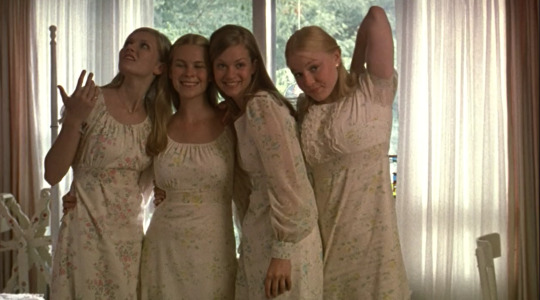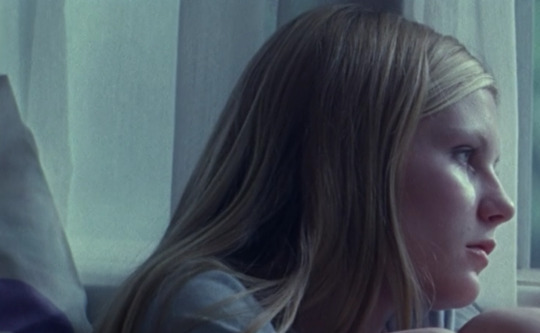#thereselisbon
Explore tagged Tumblr posts
Text
Ultra Femininity: The Virgin Suicides
TW: suicide, mental health, sexualization and sexual behavior
The Virgin Suicides, Jeffrey Eugenides’ 1993 debut fiction novel. Set in Grosse Pointe, Michigan, in the 1970s, the story follows the lives of the Lisbon sisters; five beautiful, mysterious, trapped, and ultimately cursed sisters: Cecilia (13), Lux (14), Bonnie (15), Mary (16), and Therese (17). The story is told through the perspective of an anonymous group of adult men, who are reflecting on their eye-opening adolescence and the girl’s suicides. The novel has a 1999 film adaptation of the same name directed by Sofia Coppola.
The Virgin Suicides is a tale of young teenage girls living through the examination of the male gaze, and their perspective to what the American teenage girl should be. In The Virgin Suicides, and in American culture, girlhood and beauty are dictated by the male perspective which has no room for anything that cannot be sexualized.
Spoilers for The Virgin Suicides film and novel ahead.
THE EMBODIMENT OF AMERICAN CULTURE AND AMERICAN BEAUTY
The Virgin Suicides takes place in a small town in Michigan, the picture of the post-war American suburban dream. The Lisbon girls are keepsakes, and sex symbols, but also figures of the boy’s imagination. They’re the embodiment of what American beauty should be–young, thin, blonde, alluring, and sexy, but not in a “used way.” Cecilia is dubbed “the first to go” with her odd aura. Bonnie’s description is none other than an opportunity to point out her mismatched and crooked teeth, and her “nun-like” features. Mary is known for her widow’s peak, and the small hair above her upper lip. Therese was said to be clumsy, with her “heavier face” and her “cheeks and eyes of a cow.” Lux was the only sister out of the five to meet the boy’s expectations and gaze, and she “radiated health and mischief” and was teasingly playful and capturing. The perfect American girl should be fresh and pure, but also somewhat sexually experienced, but virginal. Lux was the light of the Lisbon sisters, and the true embodiment of what an American teenage girl should be.
Grosse Pointe, Michigan in the 1970s is the picture of the American dream. A child-friendly religious neighbourhood, a beautiful yet mundane home, and simple, alluring teenage girls that would never dream of losing their virginities until marriage. This is interrupted when thirteen-year-old Cecilia attempts suicide in the bathtub. She is found in time to save her short life, but her suicide in both the novel and film adaptation is portrayed as beautiful, with words describing how her naked and “budding” body looked while she bled, and how the scene is portrayed on screen as enchanting and magnetic, rather than disturbing. This is a perfect example of how the Lisbon girls are portrayed; through their beauty and girlhood. Girlhood in The Virgin Suicides is beguiling and alluring and seductive, with brazzers dangling on top of headboards, and half-used lipsticks next to childhood tiaras. Here, girlhood is not messy, or dark, ordreary, nor is it filled with depressive thoughts, because these things do not appeal to the male gaze the girls are watched through.
Girlhood is not always beautiful, and it is not something to be picked apart by those who do not understand it.
SOCIETY’S OBSESSION WITH TEENAGE GIRLS: WHAT A TEENAGE GIRL SHOULD BE
“On the morning that the last Lisbon daughter took her turn at suicide–it was Mary this time–the two paramedics arrived at the house knowing exactly where the knife drawer was, and the gas oven, and the beam in the basement from which it was possible to tie a rope.”
The story of the Lisbon sisters is not their own–as it is told from the perspective of the boys across the street, narrating the story as adults. The girls are portrayed almost as creatures; laughing, dancing, teasing, mysterious, and curious about the world. As described in the novel, and portrayed on screen, the girls live in a beautiful mess; canopies over their beds, blankets draped over their floors, brazzers hung from crosses on the walls, and half-used lipstick tubes perfectly placed. The boy’s perspective sexualizes and glorifies these young girls–as they don’t know them, and with their fate, they never will.
The girls are figments of the boy’s imagination. Yes, the girls are very much real, but through the boy’s eyes, they’re pure, yet sexualized creatures that are a mystery to them. The girls are something that the boys can desire and yearn for in their small, white suburban town.
The Lisbon girls represent what society and the male perspective think the girls should be–beautiful, yet simple, mysterious, but not off-putting, desired, but not out of reach. The boys do not really want to know the girls–they want to fix their pain, and save them from their overbearing, religious mother, and their good for nothing father all without realizing that the girls’ lives are not for them to fix, and not for them to save.
THE SEXUALIZATION OF THE TEENAGE GIRL
“He came back to us with stories of bedrooms filled with crumpled panties, or stuffed animals hugged to death by the passion of the girls, of a crucifix draped with a brassier, of gauzy chambers of canopied beds, and the effluvia of so many young girls becoming women together in the same cramped space.”
What else is a girl supposed to do, besides apply layers of crimson lipstick, not for herself, but for the males around her? What else is a girl supposed to cry about, besides losing her music and her touch to teenage culture? What else is a teenage girl supposed to want, besides going to a dance, and to ultimately lose her virginity?
The Lisbon girls are portrayed as innocent–yet ironic in the most teenage girl way, secretly, like they won’t give themselves up if not for a price. They are a part of the boy’s imagination; their sexual imagination, but the girls do not have a perspective to their own body, and their own sexual nature. It is instead in the perspective of the teenage boys, erasing any want, desire, or need the girls may or may not have.
Lux is perhaps the most sexualized out of all the Lisbon girls–as she’s described as beautiful in her tube top that her mother always asks her to cover up, yet rebellious in her habit of chain smoking in her bathroom since the age of twelve. In the novel, Lux has a habit of writing boy’s names on her underwear in place of lacey, girl-like lingerie. In the film, we see Trip’s name written on Lux’s underwear–as if it’s giving a hint to Lux’s budding sexuality, and foreshadowing what’s to come in the football field. Lux is the ultimate girl–pure, yet sexually experienced, soft, but rough around the edges, teasing, yet arousing, and playful.
The Lisbon’s girls' suicides are told from the boy’s perspective, narrated adult years later. Instead of the suicides being a defining moment in the girls’ lives, it's a defining moment in the boys’. They’re recreating the girls’ lives through Cecilia’s stolen diary, girlhood memorabilia, and word of the mouth remembrance from the girl’s lives. They never understand that the girls are their own entity outside of their perspective, and that they do not solely exist for their viewing and sexualization.
The readers and viewers never get to know the girls from their perspective. Like the adolescent boys, the readers are oblivious observers to their girls’ real pain and suffering. The readers receive a vague explanation of this agony, which was dubbed “the first to go.”
‘“What are you doing here, honey? You’re not even old enough to know how bad life gets... “Obviously doctor, you’ve never been a thirteen-year-old girl.”’ Cecilia doesn’t explain the suffrage of being a thirteen-year-old girl, as the experience cannot be understood by the boys and their tendency to put the Lisbon girls on a beautiful and out of reach pedestal of teenagehood and girlhood. Girlhood, to the boys, is alluring and dazzling, but to the Lisbon girls, the readers never know.
“It didn’t matter in the end how old they had been, or that they were girls. But that we had loved them, and that they hadn’t heard us calling, still do not hear us calling them out of those rooms. Where they went to be alone for all of time.”
The boys, in the end, are calling to themselves. For the Lisbon girls, Cecilia, Lux, Bonnie, Mary, and Therese could not hear them in death or in living.
#TheVirginSuicides#the lisbon sisters#thelisbongirls#1999film#novel#jeffery eugenides#SofiaCoppola#cecilia lisbon#lux lisbon#bonnielisbon#marylisbon#thereselisbon#novel adaptation
128 notes
·
View notes
Text
The Virgin Suicides (2000)
Starring: Kirsten Dunst, A.J. Cook, Hanna R. Hall, Chelse Swain, Leslie Hayman, Josh Hartnett, Hayden Christensen, Robert Schwartzman, Lee Kagan, Kathleen Turner, James Woods, Jonathan Tucker, Joe Dinicol, Giovanni Ribisi, Michael Pare, Scott Glenn, and Danny DeVito
Screenplay by Sofia Coppola
Directed by Sofia Coppola
Cinematography by Edward Lachman
I do not own any of the photos posted.
SPOILERS AHEAD

This film is not about who the Lisbon girls were. The film was about the perspective in which the teenage boys saw them.
Sofia Coppola’s directorial debut The Virgin Suicides is a dreamy and whimsical perspective of teenage and religious escapism. The Virgin Suicides is narrated by an adult who speaks for the boys in a Michigan suburban neighborhood 25 years after the suicides of the Lisbon girls–Therese, Mary, Bonnie, Lux, and Cecelia. These boys, who remain anonymous throughout the film, are mesmerized by the Lisbon girls.
Cecelia, the youngest of the girls, is the first to go. After attempting suicide by slitting her wrists in the bathtub and later succeeding by jumping from her second-story window onto a fence below, the Lisbon girls, as their parents notice, slowly began to fade.
Lux is perhaps the most dazzling of the sisters, and also the most rebellious. When school begins, she begins a secret romance with school heartthrob Trip Fontaine, who negotiates with the strict Mr. and Mrs. Lisbon in order to take Lux and her sisters to the school homecoming dance. After Lux and Trip win homecoming king and queen, Trip convinces Lux to take a walk with him on the football field, where she ultimately ends up losing her virginity. Trip abandons Lux in her sleep thereafter, and they never speak again. She wakes up alone, in the middle of the school’s football field, breaking curfew. Trip, the adult narrator states, “I liked her a lot. But out there on the football field, it was different.” Trip ultimately decided to leave because the sex was not what he had imagined for both him and Lux. She wakes up the next morning to take a taxi home.
After this, the girls are confined to the walls of their bedrooms by their parents. The boys watch them through a telescope, and communicate with them through morse code and later a telephone. There are many beautiful shots of the girls lying in their rooms, reading, talking, and communicating with the neighborhood boys. This is when the girls are no longer themselves, but instead what the boys view them as. These scenes are beautiful because the boys see their beauty, more than anything else.
TW: suicide
The boys later visit the house as directed by the girls through a letter, and speak to Lux. They are invited inside under the presumption that they are to help the girls’ escape and begin to start exploring out of curiosity. They stumble across Bonnie’s hanging body in the basement and begin to flee. The boys then encounter a dead Mary in the kitchen and realized that the girls had made a suicide pact. The girls’ death symbolized who they were. Bonnie had hanged herself, Mary had stuck her head in the gas oven, Therese had overdosed on sleeping pills, and Lux had died of carbon monoxide poisoning by sealing the garage shut and leaving the engine running. They each died in different ways, and by different attempts, but in the end, they all ended up in the same place. It shows that each of the girls was different, but ultimately, were viewed as the same by those who they encountered.
I think this film is remembered for its beauty rather than the actual story. The girls’ mother is a hysteric Catholic terrified of her daughters’ budding sexuality that she adds cloth to their homecoming dresses until they appear as “four identical sacks.” Their father has good means when it comes to the girls, but is ultimately useless for the girls’ wellbeing. However, I do not believe this is what drove the girls to their death.
The boys never truly saw the girls for who they were. They never saw their pain and emotional torment from their isolated home life. The boys saw the Lisbon girls as unflawed and perfect creatures, which is what they’re depicted as in the film.
Sofia Coppola is content with the means of mystery when it comes to her films. Because we have an unreliable narrator that tells the story of the Lisbon girls, we can never truly know why they committed suicide. The lack of explanation is the whole point of the story: the girls were never truly known for who they were, but instead what they were ultimately viewed as; perfection.
The film is beautiful over everything else because the boys saw nothing but the Lisbon girls’ beauty. Even in Cecelia’s death and the remaining girls’ suicides, it was beautiful because that’s what the story truly is. The story is tedious and captivating, but not entirely real, just like the girl’s lives.
This is not to say that the girls’ aren’t real nonetheless, they are instead a form of idealism that encaptured the boys around them. That’s why I believe the film is beautiful and encapsulating, not only because that’s what the Lisbon girls’ were viewed as, but even in death, that’s what they were.
Overall rating: 8/10




#thevirginsuicides#film#filmreview#2000s#2000s movies#1970s aesthetic#sofia coppola#sofiacoppola#sofia coppola films#sofia coppola movie review#movies#moviereview#americanmovies#lux lisbon#bonnielisbon#marylisbon#thereselisbon#female directed movies#female filmmakers#female film directors#femalemoviemakers
103 notes
·
View notes